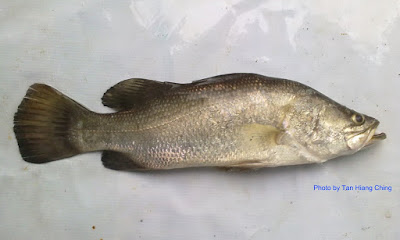Sea Perches
Sea perches or lates perches are the common names for the members of the Latidae family. The family members are distinguished by their concave snout profile. Other features include their preopercle with a stout flat spine at angle, dorsal fin deeply incised, lateral line extending onto caudal fin, and eyes with reddish reflection.
Members of the Latidae are found in the Africa, Indian and Pacific oceans. There are 3 genera and 13 species worldwide. They are excellent food fishes, and some species are of commercial importance and good sports fishes. The family members can be found in sea, brackish and freshwater, most of the time in a small group or solitary. They feed mostly on crustaceans and small fishes.
Members of the Latidae are found in the Africa, Indian and Pacific oceans. There are 3 genera and 13 species worldwide. They are excellent food fishes, and some species are of commercial importance and good sports fishes. The family members can be found in sea, brackish and freshwater, most of the time in a small group or solitary. They feed mostly on crustaceans and small fishes.
Scientific Name: Lates calcarifer (Bloch, 1790)
English Name: Giant Sea Perch, Barramundi
Chinese Name | 鱼类中文名: 尖吻鲈(Jiān wěn lú), 金目鲈 (Jīnmù lú), 盲槽 (Máng cáo), 石甲 (Shí jiǎ)
Malay Name | Nama Melayu Malaysia: Ikan Siakap
Thai Name | ชื่อสามัญภาษาไทย: ปลากะพงขาว (Plā kaphng k̄hāw), ปลากะพงน้้าจืด (Plā kaphng n̂ả cụ̄d)
Local Hokkien: Siakap, Kim Bak Lor
Local Teochew: Siakap
Local Cantonese: Seck Kap
Main Identification Features: Mouth large and jaws reaching past eyes. Lower edge of preopercle with 3 or 4 large flat spines.
Size: Maximum total length over 2 m, commonly to 1.5 m and over 55 kg.
Habitat and Ecology: Diadromous, migratory between fresh and salt waters. Barramundi are broadcast spawners that aggregate to spawn. Maturing male migrate downstream from freshwater habitats at the start of the wet season to spawn with resident females in estuaries. Spawning aggregations occur in or around the mouths of rivers after the full moon and new moon, primarily at the beginning of an incoming tide which carries the eggs into the estuaries. The larvae will remain in estuaries for several months before the juveniles move out into the freshwater reaches. They remain in the freshwater habitats until they reach sexual maturity.

Click button below to see more fish info and photo.
More
Scientific Name: Psammoperca waigiensis (Cuvier, 1828)
English Name: Waigieu Seaperch
Chinese Name | 鱼类中文名: 红眼鲈 (Hóngyǎn lú)
Malay Name | Nama Melayu Malaysia: Ikan Gelam, Siakap Laut, Kakap Laut, Selungsung
Thai Name | ชื่อสามัญภาษาไทย: ปลากะพงตาแมว (Plā kaphng tāmæw), ปลากะพงแสม (Plā kaphng s̄æm)
Main Identification Features: Jaws reach back to under eyes. Lower edge of preopercle smooth, without spines, only 1 spine present at angle.
Size: Maximum total length about 47 cm; commonly between 20 and 30 cm.
Habitat and Ecology: Coastal, rocky and coral reefs, 3–12 m depth. A marine species, they do not enter freshwater. Active during the night. Feed on fishes and crustaceans.


English Name: Giant Sea Perch, Barramundi
Chinese Name | 鱼类中文名: 尖吻鲈(Jiān wěn lú), 金目鲈 (Jīnmù lú), 盲槽 (Máng cáo), 石甲 (Shí jiǎ)
Malay Name | Nama Melayu Malaysia: Ikan Siakap
Thai Name | ชื่อสามัญภาษาไทย: ปลากะพงขาว (Plā kaphng k̄hāw), ปลากะพงน้้าจืด (Plā kaphng n̂ả cụ̄d)
Local Hokkien: Siakap, Kim Bak Lor
Local Teochew: Siakap
Local Cantonese: Seck Kap
Main Identification Features: Mouth large and jaws reaching past eyes. Lower edge of preopercle with 3 or 4 large flat spines.
Size: Maximum total length over 2 m, commonly to 1.5 m and over 55 kg.
Habitat and Ecology: Diadromous, migratory between fresh and salt waters. Barramundi are broadcast spawners that aggregate to spawn. Maturing male migrate downstream from freshwater habitats at the start of the wet season to spawn with resident females in estuaries. Spawning aggregations occur in or around the mouths of rivers after the full moon and new moon, primarily at the beginning of an incoming tide which carries the eggs into the estuaries. The larvae will remain in estuaries for several months before the juveniles move out into the freshwater reaches. They remain in the freshwater habitats until they reach sexual maturity.

Click button below to see more fish info and photo.
More
Scientific Name: Psammoperca waigiensis (Cuvier, 1828)
English Name: Waigieu Seaperch
Chinese Name | 鱼类中文名: 红眼鲈 (Hóngyǎn lú)
Malay Name | Nama Melayu Malaysia: Ikan Gelam, Siakap Laut, Kakap Laut, Selungsung
Thai Name | ชื่อสามัญภาษาไทย: ปลากะพงตาแมว (Plā kaphng tāmæw), ปลากะพงแสม (Plā kaphng s̄æm)
Main Identification Features: Jaws reach back to under eyes. Lower edge of preopercle smooth, without spines, only 1 spine present at angle.
Size: Maximum total length about 47 cm; commonly between 20 and 30 cm.
Habitat and Ecology: Coastal, rocky and coral reefs, 3–12 m depth. A marine species, they do not enter freshwater. Active during the night. Feed on fishes and crustaceans.

